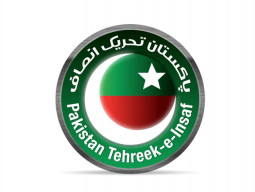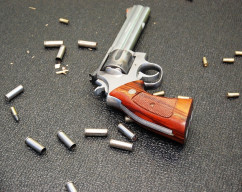
On the canvas are five people who have their backs to the viewer, wearing the keffiyeh - the traditional Arab headdress. In the foreground is a vase. What’s unusual about this bunch of flowers is that grenades hang from two of the stems.
The painting is one of the 10 artworks Ayesha Farzand, a final year MS student at the Lahore College for Women University, has put on display at an exhibition at the Shakir Ali Museum. Titled Three Dimensions the exhibition, orgnaised by the Pakistan National Council of Arts, features three artists. It opened on September 17 and will run till September 28.
Farzand’s series is titled History of the Keffiyeh and its Current Interpretation. She says she chose the head scarf because that is one of the things the West associates with terrorism. “It has become known as an accessory for the terrorist,” she says.
A 36x48 inches canvas shows flags of eight Muslim countries, including Pakistan, tied to a barren tree. A half-torn, red and white keffiyah scarf is visible on one of the branches. Another shows a man wearing it around the neck, the way it is worn nowadays. “The headdress used to be worn differently. [Its use has undergone] transition,” says Farzand.
Her paintings are priced between Rs25,000 and Rs45,000.
Rabia Yaseen, also a Lahore College student, has used architectural and cultural symbols to pay tribute to the literary genius of Waris Shah’s Heer and Jalaluddin Rumi’s Masnavi.
Yaseen describes her work as “an attempt to combine literary elements with personal experience”. Mix media painting, Union 2, shows a flute. A string – which has a bangle tied to it – comes out of one end. A peacock feather comes out of the other. At one end there’s a splash of red. Yaseen says the bangle represents a woman who is tied to a man, represented by the peacock feather. The red splash on the left represents the artist.
“At Heer’s shrine, you see girls tying a piece of cloth to a tree in the hope of finding true love. They also tie a thread to their wrists as part of the mannat,” Yaseen said.
Yaseen has eight pieces titled Sensation of Realisation on display. She says she has 70 paintings in the series, which she plans to display at a solo show in November. “[For this exhibition] I have only picked mixed media paintings. I have done a lot of work with charcoal and graphite, which will be displayed with the rest of the thesis work,” she said.
Her paintings are priced between Rs20,000 and Rs50,000.
The third artist, Amber Munir, has drawn inspiration from printed circuit boards and the Kufic script for her calligraphy paintings. Munir, who also teaches at the LCWU, says she has blended the spiral, found in leaves and thumb prints, with the Kufic script.
Munir’s done a miniature of every piece she has painted on a large canvas.
Priced between Rs25,000 and Rs30,000, most of her works are acrylic on canvas; some are water on wasli.
Published in The Express Tribune, September 20th, 2012.



1719211536-0/BeFunky-collage-(81)1719211536-0-165x106.webp)



















COMMENTS
Comments are moderated and generally will be posted if they are on-topic and not abusive.
For more information, please see our Comments FAQ